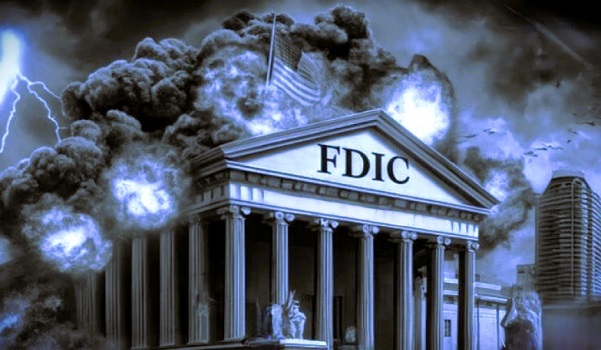BREAKING: $517,000,000,000 in Unrealized Losses Hit US Banking System, FDIC Says 63 Lenders on Brink of Insolvency
Ready to uncover the truth? Sick of the lies? Join our Telegram Channel now. It’s time for the real story! My gratitude to all my readers!
In a dramatic revelation that threatens to reshape the financial landscape, the Federal Deposit Insurance Corporation (FDIC) has sounded the alarm on an astonishing half-trillion dollars in unrealized losses within the US banking system. This staggering figure underscores the perilous state of the banking sector, with 63 lenders teetering on the edge of insolvency.
The Grim Reality: A Surge in Unrealized Losses. According to the FDIC’s latest Quarterly Banking Profile report, the banking industry is now burdened with $517 billion in paper losses. These unrealized losses, primarily stemming from the residential real estate market, represent the chasm between the purchase price of securities and their current market value. This financial abyss is deepening as banks grapple with higher mortgage rates and the ensuing depreciation of residential mortgage-backed securities.
“Unrealized losses on available-for-sale and held-to-maturity securities surged by $39 billion in the first quarter,” the report reveals.
“This marks the ninth consecutive quarter of unusually high unrealized losses since the Federal Reserve began hiking interest rates in early 2022.”
The Problem Bank List: A Growing Crisis, Adding fuel to the fire, the FDIC’s Problem Bank List has expanded, indicating a growing number of lenders are at the brink of collapse. These banks, categorized by their CAMELS composite rating of ‘4’ or ‘5’, have increased from 52 in the last quarter of 2023 to 63 in the first quarter of 2024. This represents a concerning 1.4% of the total banking institutions, a figure that, while within the non-crisis norm of 1-2%, highlights significant vulnerabilities.
The total assets held by these troubled banks have ballooned by $15.8 billion, reaching a staggering $82.1 billion. This troubling rise points to severe financial, operational, or managerial weaknesses within these institutions.
Divine Dialogue: Mysterious Secret Phrase UNLOCKS the Power to Have Every Prayer Answered Instantly!
The Underlying Factors: Inflation, Market Volatility, and Geopolitical Uncertainty
Despite the FDIC’s assurance that the overall health of the US banking system remains stable, the agency warns of persistent and pervasive risks. Inflationary pressures, fluctuating market rates, and geopolitical uncertainties continue to loom large, exerting immense pressure on the industry.
“These factors could trigger challenges in credit quality, earnings, and liquidity,” the FDIC cautions.
“The deterioration in specific loan portfolios, especially those involving office properties and credit card loans, demands vigilant monitoring. These issues, coupled with funding and margin pressures, will remain focal points of our supervisory efforts.”
RELATED:
The Biblical Times of Economic Transformation: Gold, Silver, and Copper Leading the Charge
The unfolding scenario paints a stark picture of the US banking system’s vulnerability. The FDIC’s latest report serves as a clarion call for stakeholders across the financial spectrum to brace for potential turbulence ahead. The ripple effects of unrealized losses and the precarious state of numerous lenders necessitate proactive measures to mitigate risks and safeguard the financial system’s integrity.
As we navigate this precarious financial landscape, the importance of vigilance and strategic foresight cannot be overstated. The FDIC’s revelations underscore the need for robust risk management practices, stringent oversight, and comprehensive contingency planning. The road ahead is fraught with challenges, but with concerted efforts and unwavering resolve, the US banking system can weather this storm and emerge stronger.
Additional Perspectives and Insights
To further contextualize the gravity of the situation, it is crucial to delve into the broader implications of these unrealized losses and the burgeoning list of troubled banks. The confluence of rising interest rates and the depreciation of mortgage-backed securities is a perfect storm that could have far-reaching consequences for the economy.
Financial institutions must now navigate a treacherous terrain, balancing the need for liquidity with the imperative to maintain solvency. The specter of unrealized losses becoming realized under liquidity pressure poses a significant threat, necessitating strategic maneuvers to mitigate potential fallout.
 Moreover, the escalating number of problem banks highlights a critical need for enhanced regulatory oversight and robust intervention measures. The FDIC’s role in safeguarding the banking system’s stability is more crucial than ever, demanding a proactive approach to preempt and address emerging risks.
Moreover, the escalating number of problem banks highlights a critical need for enhanced regulatory oversight and robust intervention measures. The FDIC’s role in safeguarding the banking system’s stability is more crucial than ever, demanding a proactive approach to preempt and address emerging risks.
Behind the stark statistics lie human stories—of bank employees striving to maintain stability, of borrowers facing rising mortgage rates, and of investors grappling with market uncertainties. These narratives add a poignant dimension to the financial data, underscoring the tangible impact of the banking system’s health on individuals and communities.
Strategic Recommendations for Stakeholders
For banking executives and policymakers, the FDIC’s report offers a sobering reminder of the need for strategic foresight and decisive action. It is imperative to:
Strengthen Risk Management Practices: Implement robust risk assessment frameworks to identify and mitigate potential vulnerabilities.
Enhance Liquidity Reserves: Ensure adequate liquidity to cushion against market volatility and potential realized losses.
You Must Try Nikola Tesla’s Divine Code “369” for 30 Seconds & Watch What Happens Next…
Monitor Loan Portfolios Rigorously: Pay close attention to high-risk sectors, particularly office properties and credit card loans, to preempt potential defaults.
Engage in Proactive Communication: Maintain transparent communication with stakeholders, including investors, employees, and regulators, to build trust and confidence.
Invest in Technology and Innovation: Leverage advanced analytics and financial technologies to enhance decision-making and operational efficiency.
The Bigger Picture: Economic and Social Implications
The reverberations of the banking system’s struggles extend beyond the financial sector, impacting the broader economy and society. Rising unrealized losses and the fragility of numerous lenders can stymie economic growth, curtail lending, and exacerbate financial inequality.
Policymakers must therefore adopt a holistic approach, considering the interconnectedness of the financial system with other economic sectors. Ensuring a stable banking environment is not just a financial imperative but a societal one, fostering economic resilience and equitable growth.
Future Outlook: Preparing for Uncertainty
As we look to the future, uncertainty remains a defining characteristic of the financial landscape. The interplay of inflation, market volatility, and geopolitical dynamics will continue to shape the trajectory of the banking sector. Preparing for this uncertainty requires agility, adaptability, and a relentless focus on resilience.
In conclusion, the FDIC’s alarming revelations about unrealized losses and the precarious state of numerous banks serve as a stark reminder of the challenges facing the US banking system. By embracing strategic foresight, robust risk management, and proactive regulatory oversight, stakeholders can navigate these turbulent times and steer the industry towards a more stable and prosperous future.
ARTICLE SOURCE: https://dailyhodl.com/2024/06/02/517000000000-in-unrealized-losses-hit-us-banking-system-as-fdic-warns-63-lenders-on-brink-of-insolvency/





![BREAKING MILITARY RED ALERT: TRUMP COMMANDS SILENT EVACUATIONS AS WAR SIGNALS IGNITE IN THE GULF. NO PENTAGON ORDERS. NO MEDIA WARNINGS. SOMETHING IS BREWING — AND IT STARTS AT THE TOP. [VIDEO]](https://amg-news.com/wp-content/uploads/2025/06/TRUMP-COMMANDS-SILENT-EVACUATIONS-AS-WAR-SIGNALS-IGNITE-IN-THE-GULF-450x265.png)


![BREAKING: JIHAD CALL ISSUED ON U.S. SOIL – AL-QAEDA CHIEF ORDERS AMERICAN MUSLIMS TO ASSASSINATE TRUMP, VP J.D. VANCE, ELON MUSK [VIDEO]](https://amg-news.com/wp-content/uploads/2025/06/JIHAD-CALL-ISSUED-ON-U.S.-SOIL-450x237.png)

![FALSE FLAGS & INSURRECTIONS: TRAITORS IN THE STREETS – 200 DEMOCRAT-BACKED NGOs LAUNCH COORDINATED ATTACK ON THE U.S. ARMY’S 250TH ANNIVERSARY [VIDEO]](https://amg-news.com/wp-content/uploads/2025/06/200-DEMOCRAT-BACKED-NGOs-LAUNCH-COORDINATED-ATTACK-ON-THE-U.S.-ARMY-450x233.png)
